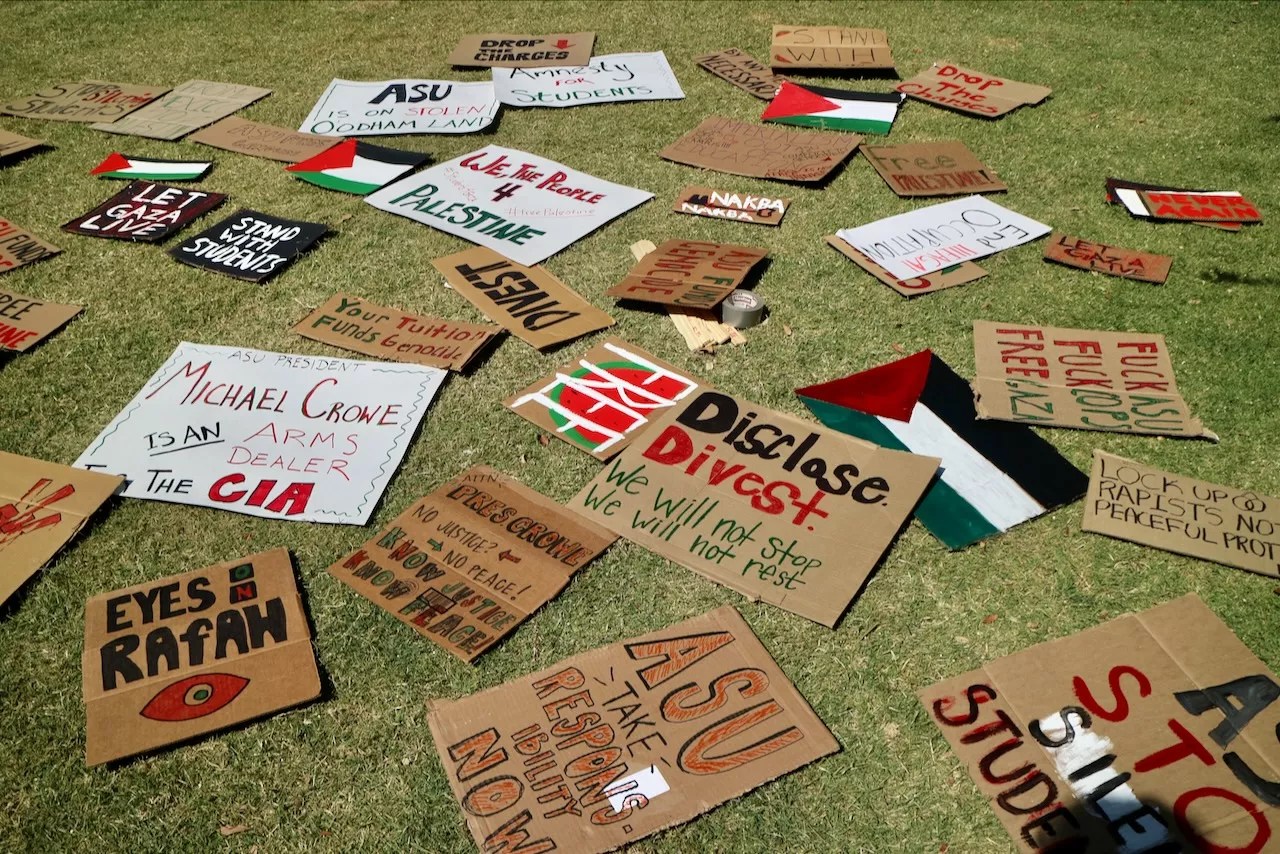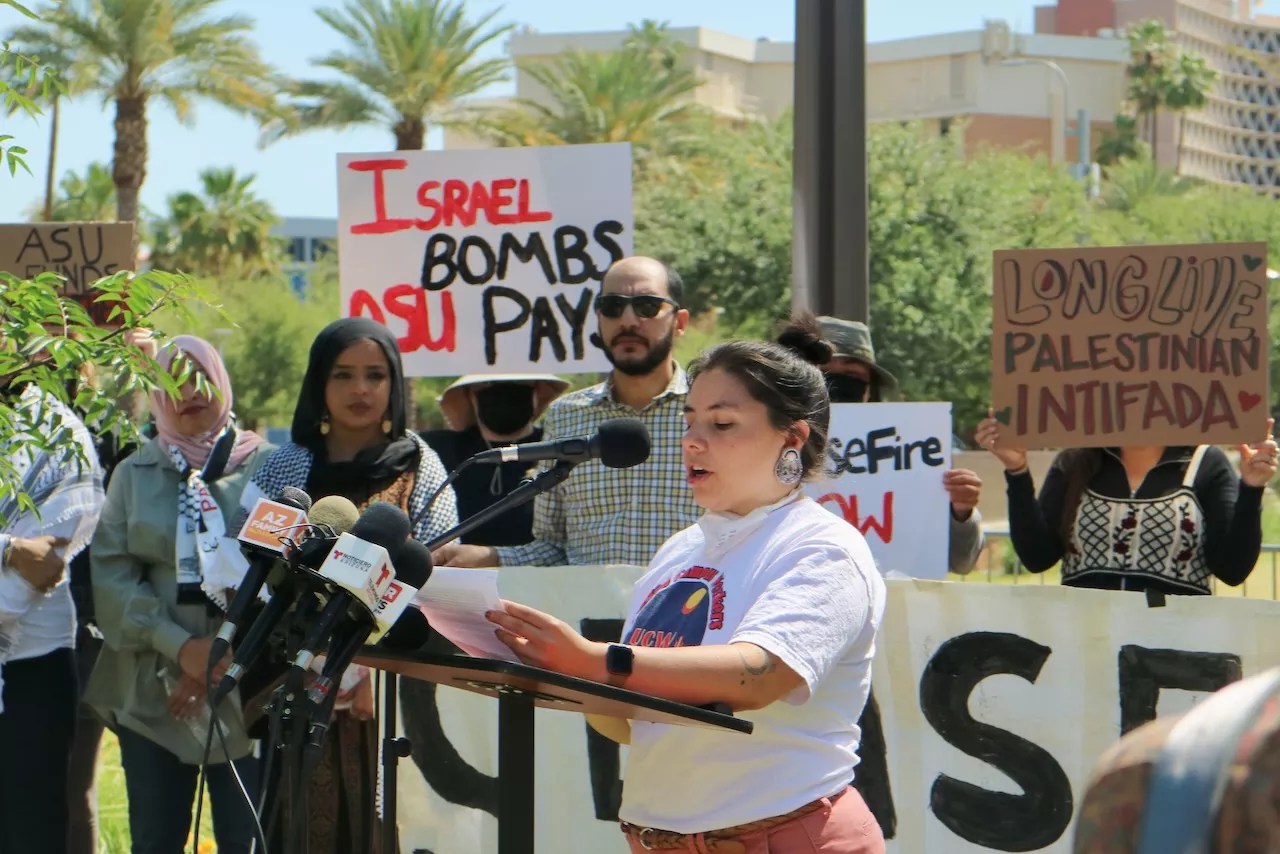
TJ L’Heureux

Audio By Carbonatix
Six months ago, a protest over Israel’s war in Gaza roiled the Arizona State University campus. A group of protesters set up an encampment on a lawn near Old Main, demanding that the school divest itself from Israel amid a war that has now killed an estimated 41,000 in Gaza, including thousands of women and children.
In response, ASU called the cops. Campus police arrested roughly 70 protesters, and the students among them were issued immediate suspensions. The incident spawned an ongoing free speech lawsuit against the university. For months, the arrested protesters were kept in legal limbo as campus police failed to process the paperwork needed to charge them.
That limbo is now over. On Oct. 9, Maricopa County Attorney Rachel Mitchell filed criminal trespassing charges against 68 protesters, while three protesters were not charged. The charge is a class three misdemeanor, which carries a maximum penalty of 30 days in jail, a $500 fine and a year of probation. Trial dates have yet to be set.
With ASU’s Gaza protests back in the news, here’s a primer on everything that’s happened since protesters set up tents on Old Main in late April.
This year, make your gift count –
Invest in local news that matters.
Our work is funded by readers like you who make voluntary gifts because they value our work and want to see it continue. Make a contribution today to help us reach our $30,000 goal!
What happened with the arrested ASU protesters?
After their arrests, the ASU protesters waited for weeks to be charged. In mid-May, their arraignments were vacated because campus police had not referred charges to the Maricopa County Attorney’s Office.
“Case numbers should have never been assigned,” Zayed Al-Sayyed, one of the lawyers representing the protesters, said at the time. “Nobody should have had to come here.”
But that didn’t mean the legal ordeal was over. Campus police had a year from the protest to formally refer charges, a process that was completed this week. In a press release, Mitchell railed against the idea that free speech rights protected protesters from criminal prosecution.
“The right to free speech does not extend to violating the law,” Mitchell said. “The university’s policy is clear – encampments are not permitted in this particular area on campus. The protestors – many of whom were not students – were given the chance, over and over again, to peacefully take down the encampments and leave the area.”
Mitchell is running for reelection next month. In a statement provided to the Arizona Republic, David Chami, the attorney leading the free speech suit against ASU, said that “prosecuting peaceful protestors is an affront to the First Amendment of our Constitution and an embarrassment to the legal profession.”
The charges formalize a scarlet letter the protesters have worn since their arrests. When their arraignments were vacated, attorneys said some protesters could not return to their jobs, which require Department of Public Safety fingerprint cards, because the arrests remained on their record. Others lost volunteer positions or summer internship opportunities.
The courts will now decide whether the protesters broke the law by disobeying ASU’s policy and whether the university violated protesters’ constitutional rights.

Attorney Zayed Al-Sayyed said “case numbers should have never been assigned” to protesters arrested after ASU police failed to charge them before their arraignment in May.
TJ L’Heureux
How did ASU punish the student protesters?
ASU brought the hammer down especially hard, issuing immediate and indefinite suspensions for those who participated. Students were blocked from speaking to professors, banned from campus and booted from campus housing.
But by the beginning of the school year in August, ASU had resolved most disciplinary matters, with only a few students still facing suspensions longer than two weeks. Many of the arrested student protesters accepted two-week suspensions instead of appealing their cases and were allowed to restart classes in the fall semester, one of the students told Phoenix New Times in August.
In order to accept the suspensions, the students were required to write an essay in which they had to rank “values” in order of personal importance and use those values to reflect on their own decision-making, the student said.
Veronica Sanchez, ASU’s director of media relations, said in a written statement to New Times, “There will be no new disciplinary proceedings initiated as a result of the filing of criminal charges. ASU’s review is ongoing.”
Chami told New Times that two students, who were not among the 68 protesters charged on Oct. 9, are stuck in ASU’s bureaucratic purgatory. Michael Clancy and Harry Smith were arrested at 9 a.m. on April 26, less than an hour into the protest, Chami said. Their charges were dropped but they’re still on interim suspension.
“ASU’s investigation is ongoing despite those two students having been present on campus lawfully,” Chami said. “The remaining students are back in class while these two students remain on interim suspension without any actions that could be even remotely interpreted as having been violative of any student code of conduct.”

A day after an April protest over Israel’s war in Gaza, a United College Workers organizer read a statement written by ASU students who were arrested.
TJ L’Heureux
What’s happening with the lawsuit against ASU?
Filed days after the arrests on behalf of 20 students, the lawsuit contends the school violated students’ constitutional right to free speech when it punished them by suspending them and barring them from campus.
The suit is still in the discovery phase, meaning a trial is still far off. Three students have been dropped as plaintiffs from the suit because “some students felt like the lawsuit was too stressful,” Chami said.
What happened with ASU police?
The protesters weren’t the only ones under the microscope during the arrests. Cameras caught ASU police misbehaving at least twice.
An ABC15 camera caught ASU Police Chief Michael Thompson out of uniform and brandishing a knife as he destroyed protestors’ tents. Thompson was placed on administrative leave in the aftermath, and he quietly retired in August. John Thompson – no apparent relation – became the interim chief in September. By retiring while on administrative leave, Michael Thompson was able to keep his taxpayer-funded pension.
ABC15 also obtained video of police forcibly removing the hijabs of several Muslim women – who “begged for ‘humanity,'” their attorney told the Arizona Republic – in an apparent civil rights violation akin to one that recently cost New York City $17.5 million.
It’s not clear if the officers who removed hijabs have been disciplined in any way. On Oct. 31, it was reported that the U.S. Department of Justice had opened an investigation into the hijab incident. In response to the DOJ investigation, the school released this statement:
“ASU has been notified of the review by the DOJ. We believe that ASU Police took actions that night consistent with recognized law enforcement practices. The university will cooperate fully with the review.”